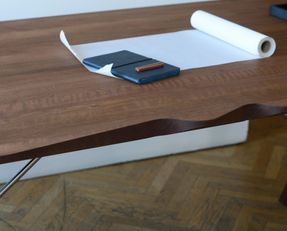
Zanat Wave Table
WAVE TABLE
WAVE TABLE
Designed by Salih Teskeredžić
The design for this extraordinary table with twisted hand-carved edges is often seen as the designer version of “live-edge,” a table that reveals the natural uneven ending of a slab of timber.
designer
SALIH TESKEREDŽIĆ
“Design in post-war Bosnia can be seen as a reaction to our socio-economic context. The bravery in creating our own design scene reminds of post-World War II period in Europe, when equal enthusiasm and energy arose.”
Salih Teskeredžić is probably the most influential and most prolific product designer in Bosnia. Born in 1962, Salih is a tenured professor of product design at the Sarajevo Arts Academy.
He founded and managed an independent architecture and design studio in Vienna (2000-2004) and in 2007 he launched a Sarajevo based architecture and design studio AD ARTE.
Salih is known for pushing the technological limits of modern furniture design in wood (his favorite material), for emotionally expressive and irresistibly elegant pieces of furniture.
His earlier work earned him of numerous design awards in the former Yugoslavia, his products were exhibited internationally and he has held three solo gallery exhibitions in Sarajevo and Vienna.
In recent years, Salih has been awarded with Red Dot awards for four of his products and a dozen Interior Innovation Awards granted by the German Design Council.
Salih is one of the founders and the art director of Gazzda, an innovative Bosnian design brand. Salih was the second designer with whom we started to collaborate before the Zanat era.
The collaboration with Salih resulted in a number of innovative pieces, which challenged our production capabilities and gave us confidence to enter the international design scene. Salih’s pieces caught the attention of design magazines such as the Monocle, as well as the New York Times.
information
ENVIRONMENT
Indoor
DESIGN
Twisted Hand-carved
THE INSPIRATION
The inspiration, however, came as the designer watched the flow of swollen Neretva River in Zanat’s hometown of Konjic after an autumn torrent.
DETAIL
The designer watched the flow of swolen Neretva River in Zanat’s hometown of Konjic after an autumn torrent. The Wave table is equally suited to be a dining table or a desk.
CARE
All Zanat products can be cleaned with soft dry or damp cotton or other soft cloth. For repairs and reoiling of oil-finished products, please consult our Care & Maintenance manual. Oil-finished dining tables come with a free care & maintenance kit. The kits can also be purchased from Zanat.
MATERIAL
Solid Wood
DOWNLOAD
↓ Data Sheet
DESIGNER
Salih Teskeredžić
EQUALLY SUITED
Dining Table Or A Desk
WARRANTY
Zanat provides a five-year limited warranty against manufacturing defects in standard products (materials and workmanship). Wear, tear and product damages is not covered under this warranty. The claims will not cover minor checks in wood, which result from relative humidity changes. Cracks in wood that result as a consequence of air humidity outside the above-indicated safe range, discolorations resulting from direct exposure of products to sunlight or otherwise improper use will not be covered under the warranty. Claims from end users must be submitted to the dealer from whom the product was purchased in order to be considered.
WOOD
All wood used in Zanat’s products comes from sustainably managed forests or private fruit orchards (walnut and cherry). FSC certificates for forest-originating wood are available upon request. Moreover, in 2021 Zanat undertook a commitment to plant three new trees for every tree we used to produce our products. Color variations and small healthy knots in wood are indications of material authenticity and cannot be considered a defect.
Wood is a hygroscopic material which absorbs and sheds moisture to adopt to the humidity of the environment in which it is placed and it expands or shrinks as a consequence. To minimize checking and cracking, all Zanat products should be kept indoors (outdoors use is OK if protected from precipitation and direct sunlight) and air humidity should not be less than 40% or more than 70%. Humidity outside this range is not optimal for human health and can result in product damage.









